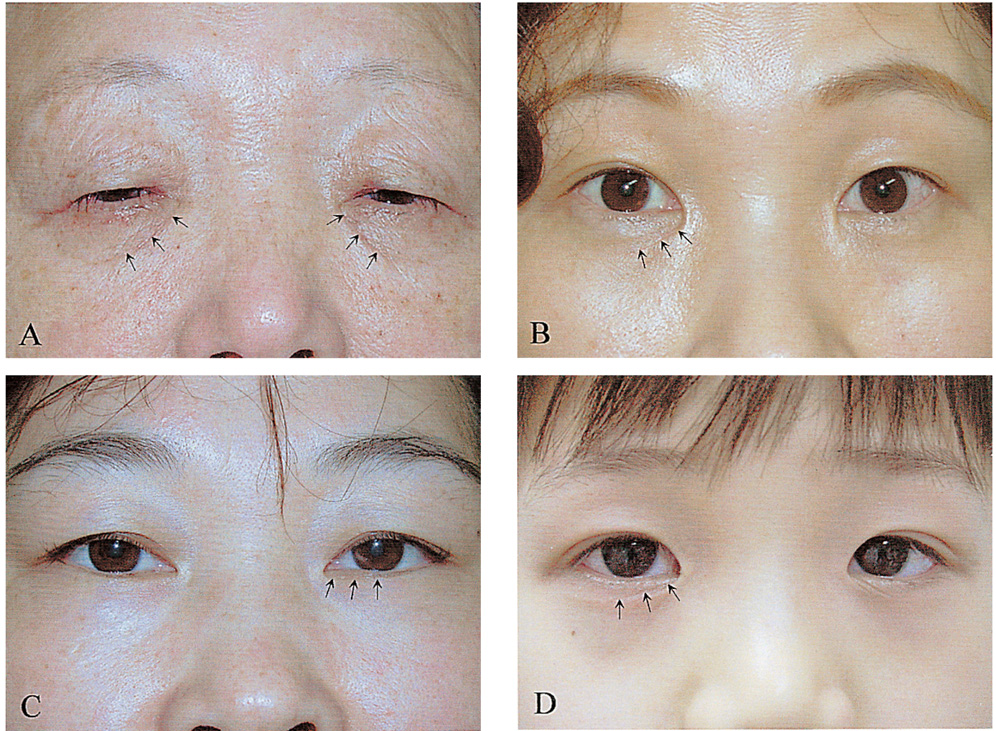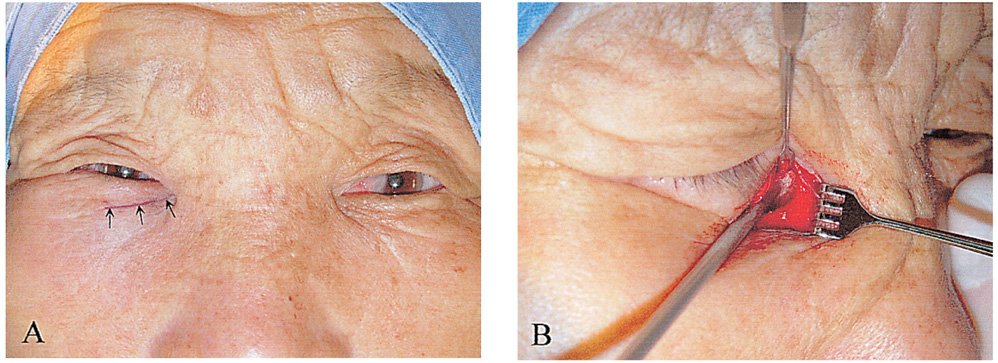Korean J Ophthalmol.
2005 Dec;19(4):243-246. 10.3341/kjo.2005.19.4.243.
Eyelid Incision for Dacryocystorhinostomy in Asians
- Affiliations
-
- 1Department of Ophthalmology, Sungkyunkwan University School of Medicine, Kangbuk Samsung Hospital, Seoul, Korea. ki.woo@samsung.com
- KMID: 754433
- DOI: http://doi.org/10.3341/kjo.2005.19.4.243
Abstract
- PURPOSE
Dacryocystorhinostomy via an eyelid incision has been described in Western literature. This study was undertaken to confirm that eyelid incision for dacryocystorhinostomy is suitable in Asians, because Asians have anatomic features that differ from those of Westerners. METHODS: We performed dacryocystorhinostomy with an eyelid incision along skin wrinkles or relaxed skin tension lines in 57 eyelids of 49 patients from July 2003 to December 2004. The medical records of the patients were reviewed retrospectively. RESULTS: Postoperative scars were easily camouflaged by wrinkles or relaxed skin tension lines of the eyelid without major complications. CONCLUSIONS: An eyelid incision can be used for dacryocystorhinostomy in Asians, regardless of the lack of a definite lower eyelid crease and the presence of epicanthus.
Keyword
MeSH Terms
Figure
Reference
-
1. Hurwitz JJ. The lacrimal system. 1996. 1st ed. Philadelphia: Lippincott;245–246.2. Linberg JV. Contemporary issues in ophthalmology. 1988. Vol. 5:1st ed. New York: Churchill Livingstone;151–167.3. Harris GJ, Sakol PJ, Beatty RL. Relaxed skin tension line incision for dacryocystorhinostomy. Am J Ophthalmol. 1989. 108:742–743.4. Putterman AM. Eyelid incision approach to dacryocystorhinostomy facilitated with a mechanical retraction system. Am J Ophthalmol. 1994. 118:672–674.5. Hurwitz JJ. The lacrimal system. 1996. 1st ed. Philadelphia: Lippincott;268–285.6. Liu D, Hsu WM. Oriental eyelids. Anatomic difference and surgical consideration. Ophthal Plast Reconstr Surg. 1986. 2:59–64.7. McCarthy JG. McCarthy JG, editor. Introduction to plastic surgery. Plastic Surgery. 1990. v. 1:1st ed. Philadelphia: WB Saunders;chap. 1.8. Dortzbach R, Woog JJ. Small-incision techniques in ophthalmic plastic surgery. Ophthalmic Surg. 1990. 21:615–622.9. Freeman MS. Incision planning and basic soft-tissue surgery. Otolaryngol Clin North Am. 1990. 23:865–874.10. Park JW, Lee BH, Jeong SK, Kim JB. Morphological evaluation of upper eyelid in Korean. J Korean Ophthalmol Soc. 2000. 41:879–885.11. Liu D, Hsu WM. Oriental eyelids: anatomic differences and surgical consideration. Ophthal Plast Reconstr Surg. 1986. 2:59–64.12. Lee Y, Lee E, Park WJ. Anchor epicanthoplasty combined with outfold type double eyelidplasty for Asians: Do we have to make an additional scar to correct the Asian epicanthal fold? Plast Reconstr Surg. 2000. 105:1872–1880.
- Full Text Links
- Actions
-
Cited
- CITED
-
- Close
- Share
- Similar articles
-
- Scar formation after lower eyelid incision for reconstruction of the inferior orbital wall related to the lower eyelid crease or ridge in Asians
- Endoscopic Laser Dacryocystorhinostomy
- CORRECTION OF THE UNILATERAL DOUBLE EYELID BY NON-INCISION TECHNIQUES
- Double Eyelid Operation in Middle-aged Women by Buried Suture Method
- Clinical Outcomes of Lower Eyelid Epiblepharon Repair Combined with Minimal Incision of Medial Epicanthoplasty



